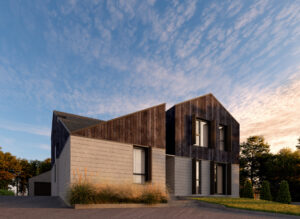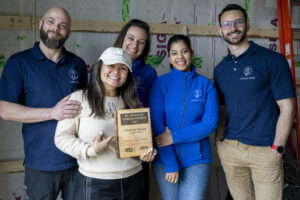Phoenix House
Projects Sponsor
When B.C. homeowners lost their home to a fire they decided to rebuild with a bold, personal, but also planetary vision. They set out to demonstrate how residential construction can achieve deep carbon reductions while remaining practical and replicable. The home they built, Phoenix House, is on track to become the first Part 9 project in Canada to meet the Living Building Challenge Zero Carbon certification. Using a full Whole Building Life Cycle Assessment the team reused materials, eliminated fossil fuels and prioritized carbon-storing products. Early collaboration across design build and LCA experts ensured performance and budget stayed aligned. Now a public case study, the project is already raising awareness in the sector.
The destruction of their house in a wildfire became a personal and environmental turning point for the devastated homeowners. They chose to see an opportunity, a chance to build not just a new house, but a model for what low-carbon climate-resilient residential construction could look like in practice. From that optimism the Phoenix House project was born.
 They set out to demonstrate how a single-family home can cut embodied carbon by more than 50% (from national benchmarks) through smart design material choices and construction methods while simultaneously meeting the rigorous requirements of the Living Building Challenge Zero Carbon certification. The new home, it was decided, would be the first of its kind for a Part 9 home in Canada, but not, they hoped and rigorously planned for, the last. The homeowners wanted to demonstrate that ambitious carbon goals can be met without compromising budget, aesthetics or functionality, making the approach accessible and replicable for typical builders and homeowners.
They set out to demonstrate how a single-family home can cut embodied carbon by more than 50% (from national benchmarks) through smart design material choices and construction methods while simultaneously meeting the rigorous requirements of the Living Building Challenge Zero Carbon certification. The new home, it was decided, would be the first of its kind for a Part 9 home in Canada, but not, they hoped and rigorously planned for, the last. The homeowners wanted to demonstrate that ambitious carbon goals can be met without compromising budget, aesthetics or functionality, making the approach accessible and replicable for typical builders and homeowners.
Before starting the project, the Phoenix House team at Carbon Wise, led by Elisabeth Baudinaud, researched the most ambitious carbon reduction targets available in residential construction. This work included reviewing the Living Building Challenge Zero Carbon certification, the BC Energy Step Code and embodied carbon intensity benchmarks from the City of Vancouver and other leading jurisdictions.
All the consulting expertise and internal best practices at Carbon Wise were set to the task of translating those targets into a practical project-specific strategy. The team modeled multiple design and material options, created a functionally equivalent baseline home for comparison and used early-stage tools like BEAM (early stage LCA software) to guide decisions. The result was a clear and achievable plan that set the Phoenix House on a path to being one of the lowest carbon homes in Canada, while delivering a durable, comfortable and cost-aware building.
 The core team— including Nick Bray Architects, Best Builders, interior designer Form Collective, technology consultant AI Technology & Design, and structural engineer and energy consultant Carbon Wise—was formed early in the design process. This early collaboration set the foundation for shared decision-making around carbon performance cost and comfort and the project team met when only rough plans of the home had been drawn to list the goals they could potentially achieve and map out how to get there.
The core team— including Nick Bray Architects, Best Builders, interior designer Form Collective, technology consultant AI Technology & Design, and structural engineer and energy consultant Carbon Wise—was formed early in the design process. This early collaboration set the foundation for shared decision-making around carbon performance cost and comfort and the project team met when only rough plans of the home had been drawn to list the goals they could potentially achieve and map out how to get there.
Together they explored the feasibility of reducing both operational and embodied carbon reusing materials and pursuing Zero Carbon certification. As the design progressed, Carbon Wise provided iterative modeling that helped the team refine strategies in real time adjusting assemblies, glazing, and material choices to reduce impact without compromising performance.
As the project progressed and its low-carbon vision became more widely known, external suppliers and manufacturers began reaching out with interest in providing support. Several offered product sponsorships or discounts, seeing the Phoenix House as an opportunity to showcase their materials in a high-performance, education-focused build. Their contributions helped make advanced low-carbon materials more accessible and in turn, educate industry professionals and the public through case studies, site visits, and upcoming presentations.
This growing circle of aligned contributors reinforced the broader goal of not just building a home, but creating a platform for learning and industry transformation.
No construction project is without its hiccups and surprises, and one of the biggest challenges came from the team’s decision to raise Phoenix House on the existing concrete slab—a key strategy to reduce the project’s embodied carbon. While this avoided the emissions of pouring new concrete it introduced unexpected complications with radon mitigation. On top of that, the local municipality had never encountered a scenario where a foundation slab was reused in this way and as a result there was no clear regulatory path. This led to confusion, additional engineering requirements, and increased costs for the homeowners along with delays in approvals.
Another major obstacle was financing and insurance. The project’s higher upfront design and consulting costs, necessary to meet advanced sustainability goals, were difficult to justify in a system that still sees homes as checklists of square footage and code minimums. Lenders and insurers showed little understanding of what the project aimed to achieve, reflecting how out of step financial systems are with the rapid evolution of climate-conscious construction.
These issues were resolved through clear documentation, proactive communication with municipal officials and a team-wide commitment to staying aligned with the project’s goals. These setbacks reinforced that while individual innovation is necessary, the systems around us need to evolve just as quickly.
Throughout construction, Carbon Wise continued to support the team by providing airtightness diagnostics and verifying that the home would meet Step Code and Zero Carbon Step Code targets. This ongoing technical guidance ensured the project stayed aligned with its carbon goals throughout and the home is on track for completion in September 2025 with final certification and public case study publication to follow.
More than a delightful home is a model home. Extremely low-carbon metrics (in terms of both operational and embodied emissions) were achieved by reusing the foundation, minimizing glazing and using carbon-storing materials like cellulose and hemp insulation. The project pushed design innovation in a Part 9 residential context proving that deep emissions reductions are possible even in custom homes with real-world constraints.
The unvarnished documentation of the entire project means Phoenix House will be a living, lived in, educational tool. The homeowners choose to document the journey on film not as a polished HGTV-style show but as an honest unfiltered look at the real challenges and decisions involved in building a truly low-carbon home. Phoenix House exists not just as a house but as a public case study, presented at industry events (like Buildex and the Home Show) and shared with builders’ associations to inform and upskill the market. Other teams can learn from the Phoenix House project how to apply lifecycle thinking not just in theory but in practice.
Phoenix House may be the first Canadian certified zero carbon home on the block but everything about it, design and process, was done to ensure it won’t be the last.













